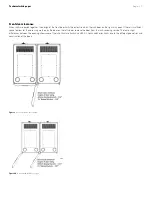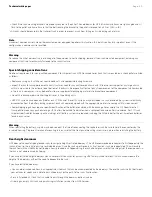
Technical white paper
Page 8
installed. The same baying kit will support the 10000 G2, Advanced, and G2 Advanced Racks. This baying kit is used to connect racks of the
same depth.
HPE Offset Baying Kit
Offset baying kits are used to connect adjacent racks that are of a different depth. Kits are available that support the connection of 1075mm
deep racks to both 1200mm racks and older 1000mm deep racks.
HPE Stabilizer Kit
Fixed stabilizers are anti-tip feet (front and side) that provide stability and support when equipment is installed, removed, or accessed within the
rack. Both HPE 600mm stabilizers and HPE Heavy Duty 600mm stabilizers are available. For single racks or bays of three racks, with rack-
mountable components, on extendable rails, that are less than 100 kg (220 lb.), a standard 600mm stabilizer is required.
If racks are secured together with baying kits, the side feet installed on each end of the row of racks are considered optional. Rack rows with four
or more bayed racks do not need a stabilizer kit installed.
HPE recommends using stabilizer option kits when one or more of the following situations occur:
If a standard 600mm (23.62 in) front stabilizing foot is installed on a standalone rack, the side feet, provided with the fixed stabilizer kit, should
also be installed to stabilize standalone racks from the side.
•
A heavy-duty 600mm (23.62 in) front stabilizer foot is required in either of the following situations:
–
A single rack-mountable component, on extendable rails, weighing 100 kg (220 lb.) or greater is installed in a standalone rack.
–
A rack row of three or fewer racks are bayed together
•
To reduce the risk of personal injury or damage to the equipment, be sure that:
–
The leveling feet are extended to the floor
–
The full weight of the rack rests on the leveling feet
–
The stabilizing feet are attached to the rack if it is a single-rack installation
–
The racks are coupled together in multiple-rack installations
–
Only one component is extended at a time or the rack may become unstable
HPE Ballast Option Kit
Ballast plates add weight to a rack and improve side-to-side and front-to-back mechanical stability for standalone racks or a row of three or fewer
racks bayed together. Ballast plates fit in the zero-U space at the interior sides of the rack and should be installed into the rack prior to
installation of any other equipment.
When increasing rack weight, it is important to consider that a rack with a light static load (less than 95 kg/210 lb.) should have ballast plates
installed to provide extra weight, thus reducing the possibility of the rack tipping over if a significant force were to be applied to the rear or side
of the rack. Racks with a heavier static load (greater than 95 kg/210 lb.), depending on the particular configuration involved, may not require
ballasts.
Multiple ballast kits may be necessary to provide sufficient weight. Each kit contains two 18 kg (40 lb.) ballast plates. Ballast plates should be
added to the rack until the total weight of components installed into the rack is at least 95 kg (210 lb.).
For example, a lightly loaded rack configured with 23 kg (50 lb.) of equipment requires two ballast kits (four ballast plates). The total weight of
four ballast plates is 72 kg (160 lb.). Therefore, the total installed weight of the rack components would be 95 kg (210 lb.), the minimum
recommended rack installed component weight.
Should any rack component on extendable rails weigh more than 46 kg (100 lb.), there must be an additional 95 kg (210 lb.) of equipment
weight in the rack (excluding the weight of the component) to provide balance and maintain rack stability when the component is extended on
its rails. In this instance, ballast plates should be added until the total rack component weight is 138 kg (300 lb.) or greater.
Total weight of installed equipment along with total weight of ballast plates is equal to total rack component weight.
























